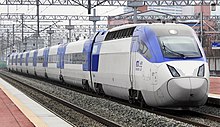| Republic of Korea | |||||
|---|---|---|---|---|---|
 KTX train | |||||
| Operation | |||||
| National railway | KORAIL | ||||
| Infrastructure company | Korea National Railway[1] | ||||
| Major operators | KORAIL and SR | ||||
| Statistics | |||||
| Ridership | |||||
| Passenger km | |||||
| Freight | 28.7 million tonnes (2019)[3] | ||||
| System length | |||||
| Total | 4,285 km (2,663 mi) (2020)[3] | ||||
| Double track | 2,790 km (1,730 mi) (2020)[3] | ||||
| Electrified | 3,187 km (1,980 mi) (2020)[3] | ||||
| High-speed | 625 km (388 mi) | ||||
| Track gauge | |||||
| Main | 1,435 mm (4 ft 8+1⁄2 in) | ||||
| High-speed | 1,435 mm (4 ft 8+1⁄2 in) | ||||
| Electrification | |||||
| Main | 25 kV AC 60 Hz | ||||
| 25 kV AC | All Korail operated network except Ilsan Line | ||||
| 1.5 kV DC | All rapid transit networks including Korail Ilsan Line | ||||
| Features | |||||
| Longest tunnel | Yulhyeon Tunnel 50.3 km (31.3 mi)[4] | ||||
| No. stations | |||||
| Highest elevation | 1,225 m (4,019 ft) | ||||
| at | Chujeon Station | ||||
| Lowest elevation | −36 m (−118 ft) | ||||
| at | Yeouinaru Station | ||||
| |||||
Railways are a part of the transport network in South Korea and an important mode of the conveyance of people and goods, though they play a secondary role compared to the road network.[5][6][7] The network consists of 4,285 km (2,663 mi) of standard-gauge lines connecting all major cities with the exception of Jeju City on Jeju Island, which does not have railways; of the network, 2,790 km (1,730 mi) are double-tracked and 3,187 km (1,980 mi) are electrified.[3] In 2018, rails carried 11.5 percent of all traffic in South Korea – 134.8 million passengers and 30.9 million tonnes of freight – with roads carrying 88.3 percent.[8][9]
Passenger and freight services are primarily provided by the Korea Railroad Corporation, branded as Korail, a state-owned enterprise under the Ministry of Land, Infrastructure and Transport, although some rail lines and services, including high-speed intercity rails and metropolitan rapid transit, are operated by private companies. The Korea National Railway (formerly the Korea Rail Network Authority), another state company under the Transport Ministry, is responsible for constructing and maintaining the railway infrastructure, with Korail and other rail operators paying track access charges to Korea National Railway. Both Korail and Korea National Railway were created in 2004–2005 after the government decided to split the state-owned Korean National Railroad.[1][10][11]
